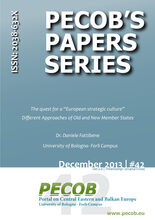and Balkan Europe
by IECOB & AIS Università di Bologna

The quest for a “European strategic culture”. Different Approaches of Old and New Member States
December 2013 | #42
by: Dr Daniele Fattibene
pp: 67
ISSN: 2038-632X

Abstract
The Iraqi war created a clash within the European Union between the so called “Old” and “New Europe”. This division was soon associated to another one, that between “Atlanticists” and “Europeanists”. Many scholars tried to show that the enlargement process undermined EU capacity and political willingness to build its own “strategic culture”. New member States were too keen to recognize USA and NATO as the main guarantors of security in the Continent, while they constantly frustrated Old members attempts to build a stronger EU Common Foreign and Security Policy. The aim of this paper is to show that there have always been different types of “strategic cultures” in Europe and that new Members’ alleged “Atlanticism” was not just an “anti-European” stance. On the contrary, it was a complementary step towards the creation of a more independent EU security capacity. Moreover, the enlargement process showed that the main rift between Old and New Member States had to be found on the Eastern border, rather than on the Western one. Central and Eastern European Countries’ dynamism towards EU eastern neighbours showed the attempt by new Members to shape the European “strategic culture”, by protecting their strategic interests in the Eastern Neighbourhood. Although the European Neighbourhood Policy as well as the Eastern Partnership Initiative, became sources of misunderstandings within EU Institutions, they showed how willing new comers were to contribute to enhancing EU security. Both Transatlantic Trends and Eurobarometers highlight that even the most traditionally enduring “Atlanticists” are becoming “Europeanized”, by advocating an increased “communitarian” approach to strengthen EU CFSP/CSDP effectiveness. In this sense, looking at both Polish and Lithuanian cases will allow us to realize that, despite persistent scepticism, Central and Eastern European Countries cannot be considered anymore as “US Trojan Horses” in Europe. Therefore, only by including their projects and dynamic ideas in a reinvigorated debate over “European strategic culture”, this strategy will become common also in practice. EU must use its “holistic approach” to overcome domestic misunderstandings and divergences and build up a “strategic culture” whose pillars will be both collective decision-making process and shared goals.
This is the only recipe to create a new global equilibrium, based on a “concert of projects”, rather than on a potentially disruptive “balance of power”.
Keywords
Strategic culture, Old and New Europe, EU enlargement, EU CFSP, Atlanticism, Europeanization, European Neigbourhood Policy, Eastern Partnership, European Security Strategy
Table of contents
ABSTRACT
LIST OF ABBREVIATIONS
INTRODUCTION
IRAQI WAR: THE EMERGENCE OF “OLD AND NEW EUROPE”
EUROPEAN AND US STRATEGIC CULTURES
CEE BETWEEN NATO AND EU CFSP
A DIFFERENT ATLANTICSM: “ATLANTICISTS BECOMING EUROPENIZED”
“NEW EUROPE” ACTIVISM:THE EASTERN DIMENSION OF THE ENP
THE DEBATE ABOUT CEE ROLE IN THE EASTERN PARTNERSHIP
THE LISBON TREATY: A NEW FRONTIER FOR NEW EUROPE
POLISH STRATEGIC CULTURE: THE HISTORICAL LEGACY
A NEW TRANSATLANTIC ACTOR?
POLAND EASTERN DIMENSION
CURRENT TRENDS : THE “EUROPEANIZATION” OF POLISH FOREIGN POLICY
AN EMPIRICAL OVERVIEW: TRANSATLANTIC TRENDS 2012
LITHUANIA: “THE GOLDEN PROVINCE OF EUROPE”
THE “DUAL LOYALTY” OF LITHUANIA’S STRATEGIC CULTURE
VILNIUS ACTIVISM IN THE EAST
NEED FOR “COMMUNITIZING EU CFSP”
CONCLUSIONS
BIBLIOGRAPHY
AUTHOR’S NAME
Download the paper
PECOB: Portal on Central Eastern and Balkan Europe - University of Bologna - 1, S. Giovanni Bosco - Faenza - Italy
Chiudi la versione stampabile della pagina e ritorna al sito.
 Download the full paper!
Download the full paper!